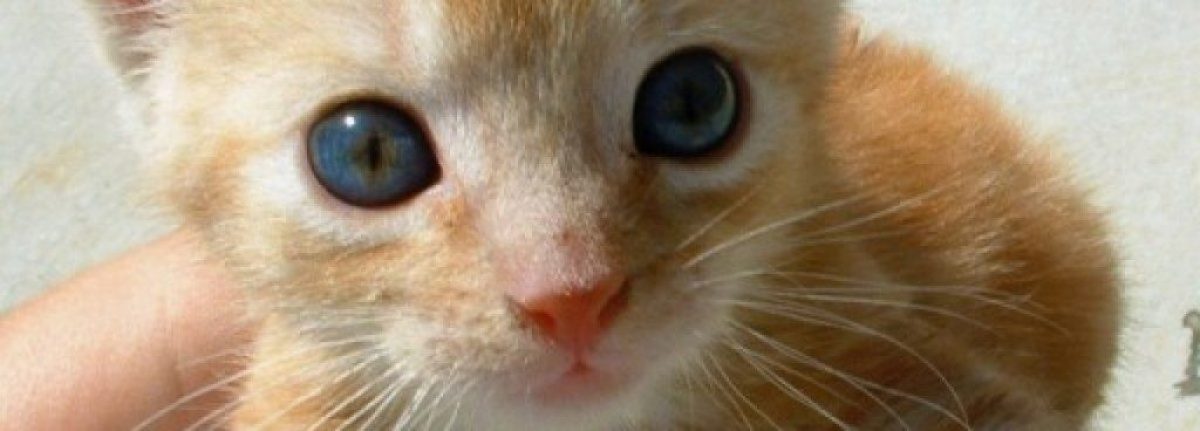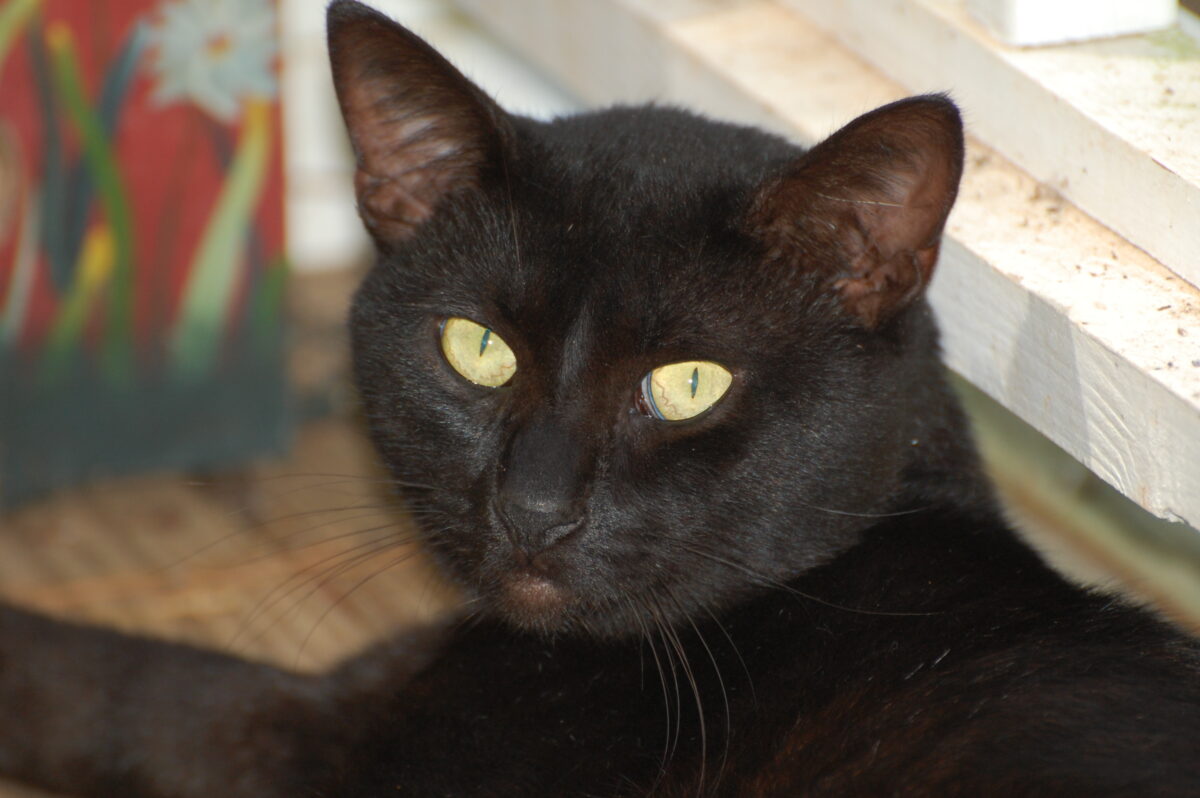Cappie (not originally his name) was initially cared for by a former neighbor who managed a feral colony that lived behind her house. She loved all cats and thankfully, this neighbor practiced spay, neuter and vaccinate; so most of her colony was “fixed”. There were only 3 or 4 that had not been fixed and Cappie was one of them.
He had a difficult time from the beginning–always needing special care for one reason or another. According to his former caregiver, Cappie, is the brother of Licorice, but she said that one day she found Cappie lying in the middle of the road not moving. She said he couldn’t get up and couldn’t walk, but it appeared he was uninjured. Her story was that she picked the cat up and put him in her shed where she kept him on blankets and puppy pads near an oil filled heater, with food and water very near his head. She didn’t mention whether or not she had taken him to the vet, but said that one day he came walking out of the shed.
A couple of years later, this neighbor moved away. She captured as many cats as she could from the colony she was managing and took them to her new property where she had turned the garage into a shelter for them. There were a few that she couldn’t catch or find and she said that she would come back for them, soon. It appeared there were three that she didn’t take with her, possibly four. Cappie was one of these four; and also one of the ones she had not gotten around to neutering.
Eventually, Cappie, and Licorice, made their way to our property in need of a food source. When Cappie showed up he was limping on all 4 legs or feet. It appeared that when he stood his front legs bowed backwards and he would have to stop and rest every few feet, probably due to pain. He would not let me near him and I assumed he had at some point broken his legs and that they had improperly healed. This couldn’t have been farther from the truth.
Cappie stayed on our property when he found there was a good supply of food, water, and shelter available to him. Although we named him Captain Hook, because his tail was permanently curled into a hook shape at the end, we called him Cappie. Other than the obvious handicap he had with walking, he seemed to be in good health otherwise.
I worked very hard to “gentle” Cappie and eventually he let me handle him for short periods. I checked his legs and they didn’t feel as though they had been broken, but I did note that all of his paw pads were swollen and ulcerated and that the top of his head also felt a little spongy. Cappie was also leaving bloody foot tracks everywhere he walked. So rather than use a low-cost spay/neuter clinic to simply have him fixed, I made an appointment with a regular veterinarian so that he could be neutered and vaccinated, and to have his legs, feet and head checked thoroughly.
I dropped Cappie off at the vet and before I got back home the veterinarian called me indicating that he had neutered Cappie, but that there was a bleeding issue and that his prognosis was very poor in general. He had given him a rabies shot but didn’t think it was wise to give other vaccines at this point and wanted to know what I wanted him to do with the cat. I felt he was asking if I wanted to euthanize; so I asked the vet to stop the bleeding and do his best work for Cappie, and told him I would pick him up that afternoon.
After picking up Cappie from the vet, I took him home to the building where I intended to let him live out the rest of however many days he had left. The vet had me very discouraged and thinking that he wouldn’t last long. Though I told the vet that I could medicate the cat if he prescribed meds, he failed to prescribe anything for him because he himself had a very difficult time handling the cat. He probably felt that I would have a difficult time medicating him.
The vet had grafted skin over the ulcerated paw pads, but had his doubts that the grafts would take and felt that there was no hope for the cat’s extremely soft and mushy paw pads or the cat’s life. He also said that it would take several days for the neuter location to stop bleeding completely.
The vet was right about the skin grafts. They failed, and Cappie was back to leaving bloody footprints everywhere and he was still having some light bleeding from the neuter surgery. I started Cappie on some vitamin K1 to help the blood to clot. I added it to his food 2 times daily for 7 days. Within 2 days all bleeding had stopped, including the oozy paw pads; even though they still appeared to be open wounds.
Then, not long after the grafts failed, Cappie started smelling extremely bad. His paw pads were raw, he had stopped grooming, he was gnawing at his feet, and he had stopped getting up at all. He would only rise to eat his meals and I thought that we would lose him soon.
I did some research on feline paw pad issues and immediately came across an article describing specifically the symptoms that Cappie was demonstrating. I learned that this particular foot ailment is called pododermatitis, or pillow foot, and that it is very hard to treat, but that it can also spontaneously heal under certain circumstances. Left untreated it can cause a yeast infection of the skin that will cause the cat to smell badly. The recommended treatment was first to treat with amoxicillin and betadine solution sponge baths to get the yeast infection under control, and then to treat with doxycycline for 6 months to address the feet.
Here’s what pododermatitis (pillowfoot aka spongy foot disease) looks like:
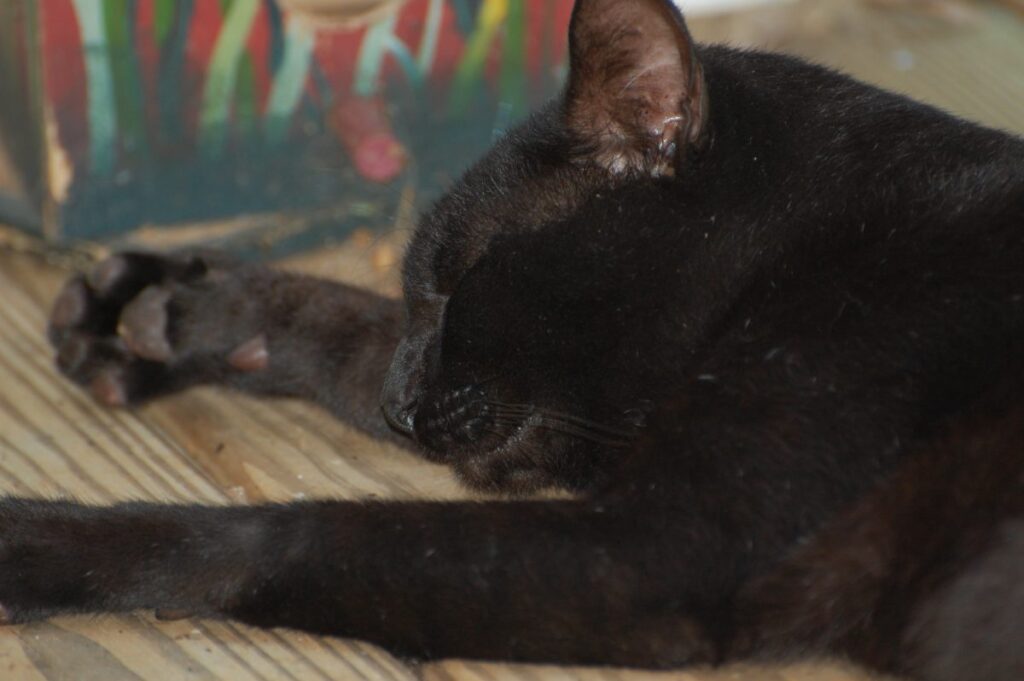
To give you an idea of how painful and debilitating this ailment is, below is a view of various stages of pododermatitis. This causes an animal to be lame and the distance they walk, as well as what they walk on, should be limited. Pavement, gravel and dirt can all do damage to these feet. Tiny grains of sand get embedded in the abscesses, which in turn cause over grooming of the feet to alleviate pain, while it essentially worsens the condition. All of Cappies pads had ulcers as shown in the left side of the below image.
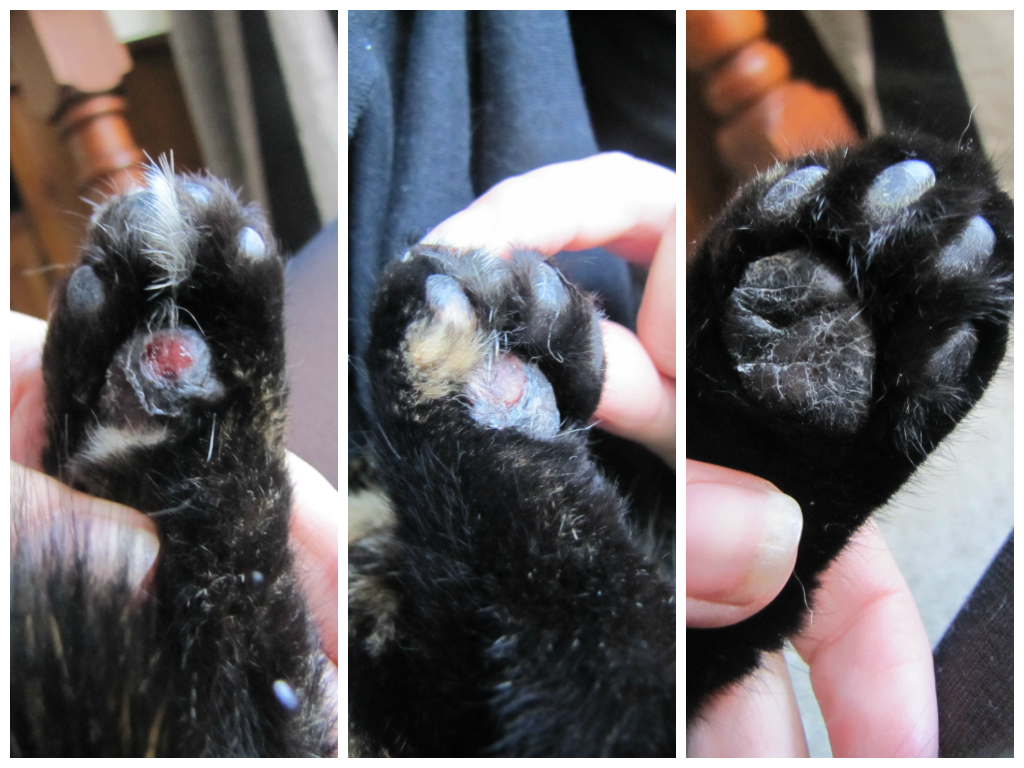
I had some amoxicillin left over from a previously ill cat, as well as some betadine solution, and so thinking the situation could get no worse, I went to work on Cappie. I had just enough amoxicillin to give him 2 doses a day for ten days and plenty of beta-dine on hand. Cappie absolutely loved the sponge baths and brushing. I also wrapped his feet in very wet cloth that I had drenched in beta-dine solution and let them soak while doing the sponge bath. It was adorable how Cappie would stretch out on the floor and purr the whole time I was doing this for him.
Within 2 days of receiving antibiotics and the baths the swelling on his feet began to reduce and the odor was gone. Within 4 days of receiving antibiotics his raw paw pads appeared to be healing. Excited about the improvement, I went in search of doxycycline for him and finally got what he needed just in time to pick up where the amoxicillin left off.
I noticed that he had some claws that were curling toward his paw pads. I cut them very short. It took me 4 days to cut all his claws, because he still had some pain and he would try to bite me if I tried to do too much at once.
Within 2 weeks of starting on the doxycycline the abscesses on his feet had healed and the swelling continued to decrease. I kept up the treatment, and within a month I noticed that his paw pads were starting to regain some firmness. Within 2 months the swelling was completely gone, his front paws were still firming up, and most of the back paw pads were continuing to firm up. The large pads on the back feet were being slow to firm but were healed otherwise.
Within 3 months, Cappie started flexing his paws while lying idly in his bed. He started grooming himself again and then he started walking around in the building. When he started walking around, he made a happy habit of frequently using the scratching post.
I felt he was well on his way to being well. Three more months of treatment to go, and he kept improving daily. His coat became shinier than ever before and he came to look forward to his twice daily treat of milky doxycycline.
By the time the 6 month mark rolled around, Cappie was playing happily in the building and had found the tunnel to go outside to the kennel where he could lie in the sun. He spent a lot of time sunning in the kennel and his limp was completely gone. His legs no longer bowed backward while walking and he looked great!
I finally started letting him out of containment for exercise up to 4 hours a day, but he suddenly picked up the habit of venturing to and lying in the middle of the road, and so of course, he was returned to the building for many more months. Eventually I was able to allow him outside daily without his venturing to the road.
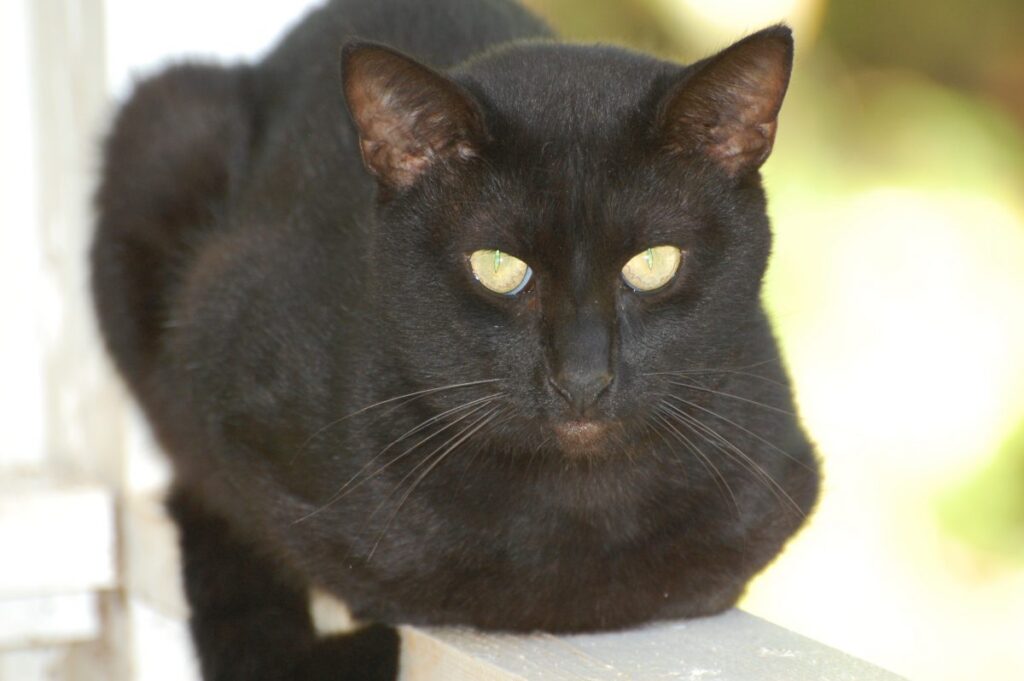
Cappie finally became healthy enough for vaccinations and I administered them in June. It was at this time that I noticed that Cappie’s head no longer felt spongy. It was amazing the turnaround Cappie’s health had made, and how beautiful he became.
It was with a very heavy heart that we suddenly lost Cappie to old age issues in August 2017. We are happy that we were able to give him many years of care, providing him with a chance to experience a sheltered, healthy life with loving companions and care givers.
